Recently, we lost Ricky Jay—an irascible and preternaturally talented conjurer and actor. He was capable of amazing works, many of which are recounted in this 1993 New Yorker profile. His life’s work lay in the preservation of the art of American sleight-of-hand. In reading up on him, one thing is clear: he loved magic and hated magicians. There’s something comforting in that.
One of his books—long out of print, but available to those with flexible morals and internet access—is Cards as Weapons, a tongue-in-cheek pitch to the Department of Defense of using playing cards in warfare. Through that conceit, he teaches the basics of throwing cards and ties it into a vector-based divination systems based on arrows. It’s a good read for Magic players, although it’s rife with a sort of 1970’s-era Orientalism and an assumed and affected voice, like reading jarring comics from a different age. It’s useful, though, because we’re trained to think of Magic cards as weapons. When we beat our opponent, we remember the card that killed them—the final Lightning Bolt or the Tarmogoyf that got all the way there. We think of our Doom Blades and our Guttural Responses as implements of warfare. What we’re not trained to do is to think of Magic cards as tools of divination—beyond, you know, actual Divination.
An aside, to be read in the staccato and oratory voice of a magician keeping your focus of their hands: Nephelomancy is the art of divination through reading the shapes of clouds like tea leaves. Haruspicy is the art of reading entrails. Tasseography is divining the future through the shape of tea leaves left at the bottom of a cup. Flaneuromancy, which I’ve just invented, is reading meaning from urban layouts. Cartomancy, while a more boring name, is just what it sounds like: reading the future through cards. Generally, of course, this means Tarot, but anything randomized that can be shuffled and laid out in occult patterns is fair game.
The different connotations encoded on Planeswalkers are as suggestive but opaque as the icons of the Tarot. Knowing that Death means rebirth when in the Thoth deck (because Crowley was an insufferable edgelord) is a similar skill to knowing that Tezzeret, Agent of Bolas represented a time in the game’s lore when the artificer turned against his homeland and our heroes. I foresee a time when Magic isn’t just a game, but a parlor-ready fortune-telling tool. That day isn’t today—today, we’re focusing on what we can tell about Magic’s future from the cards Wizards has picked to represent the Ultimate—and ultimate—version of the Masters series.
First off, because Ultimate Masters was designed to be draftable, there’s a fair selection of limited-only cards—while I’d love to see a true zero-bulk Cube-style set, that’ll have to wait for Magic’s twilight, when Wizards (or whoever owns the intellectual property at that point) pulls out all the stops. In the meantime, we’ll keep seeing Dawn Charm and Mad Prophet and Vengeful Rebirth serve as the mortar that keeps Limited formats upright. These are predictable boring decisions, and ones arrived upon through constant, high-level iteration.
Likewise, there’s not too much interesting about the staples. Wizards of the Coast wants to increase access to Liliana, Snapcaster, Goyf, and the Eldrazi. That doesn’t require any kind of anagogic literacy to decipher. But there are some picks that suggest rationales beyond just “reprint this until there isn’t a Reddit thread complaining about it this week” or “seems like it would help out the Reanimator archetype while offering help to Burn decks in draft.” Among them:
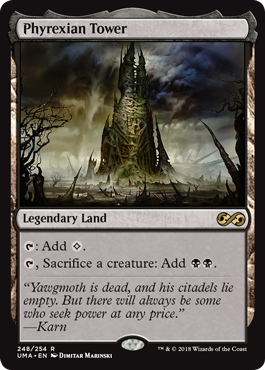
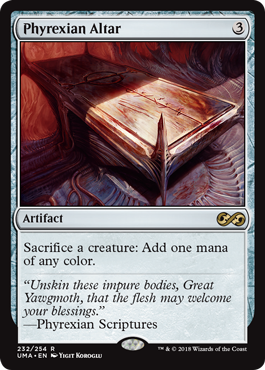
Both Phyrexian Tower and Phyrexian Altar were clocking in at $50 until last week. Tower is a staple in Nic Fit and assorted Academy Rector decks, as well as a desirable Commander value card. Altar was upheld specifically by Commander—it’s only legal in Vintage/Legacy and casual formats—and I think it will rebound hard by next year. It’s highly played, and will create a new micromarket of people who balked at $40 but will happily pay $13 until the supply is gobbled up.
Tower was a surprise—reading Twitter and Reddit threads on the spoiler, it appears the bulk of (vocal) viewers thought it was on the Reserved List with Cradle, Sanctum, and Academy. It’s too bad the Masters series went dormant before they could reprint Food Chain, Manabond, Sphere of Resistance, or give another round of reprints to other Eternal playables. But clearly, there’s a cross-format database of reprints that Wizards can rely upon to build up reprint value in their sets. We can infer this from one specific inclusion: Back to Basics—it only truly blew up in the last few months and was under twenty dollars until summer 2017, and so must have been a panic inclusion in the set.
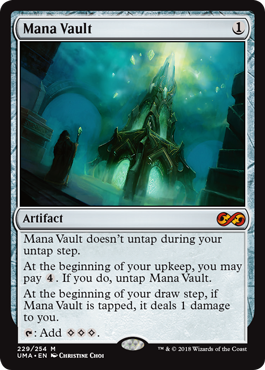
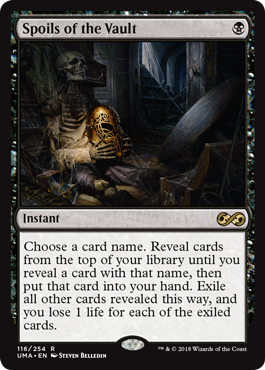
Meanwhile, if I had to stake money on it (and I do and will), Mana Vault is the Mana Crypt of the set. Crypt was $45-55 for several weeks back in 2017, and Vault is going to create a new market, rather than satiate an existing one. It won’t be $145, like Mana Crypt, but it will rise over the next year as more and more Commander players see it used against them and decide maybe that they want to try some of that Mana Vault.
Speaking of vaults, it’s clear that there was an Ixalan Masterpiece series with a theme of tutoring (i.e., searching for treasure) at one point. Spoils of the Vault was in it, along with Scapeshift, Demonic Tutor, Vampiric Tutor, and Gamble. I’d love more details on that discontinued series.
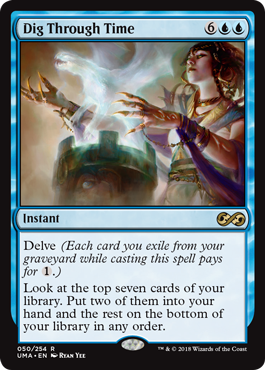
I have no clue how Dig Through Time got into the set, ironcially enough. It’s banned in competitive formats, under a dollar, and printed last in 2014. But Dig is an absolute blast to play, and might have been even more fun downshifted to uncommon. Prediction: someone at Play Design thought it was funny. They’re not wrong.
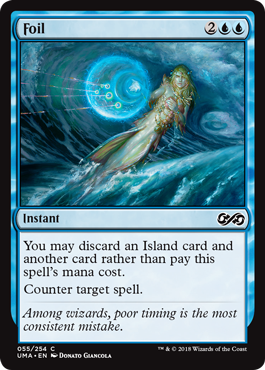
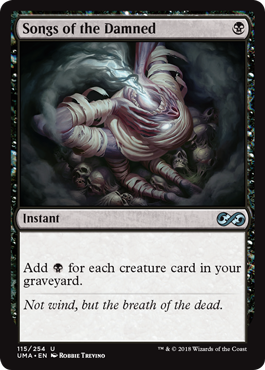
And then we have Foil and Songs of the Damned. One a downshift, one a cosmetic upshift (while still maintain Pauper legality). I’m excited to test Foil out in Pauper more than almost anything in this set—it’s massive card disadvantage, but anything that suggest the old Forbid-based decks of 1998 appeals to me greatly. You better believe it’s in my Pauper Reanimator right now.
What’s missing, above all, is recent Modern staples—the matured but high-supply cards that maintain value. The heavy hitters, as mentioned, are there, but it’s time to get more copies of Collected Company, Collective Brutality, and Cryptic Command out there—and that’s just the “C’s!” I’m assuming there will be some boxed set—possibly a structured Cube, with a Mythic Edition-style premium inclusion—that includes these and other lower-priority staples (looking at you, Goblin Lore). Expect that in first quarter 2020, if I had to guess, or in summer 2019 if there’s a shakeup in formats (e.g., a post-Origins/Arena-legal format) and Modern needs a sudden jolt to stay current and lucrative.
Aside from this handful of predictions and prognostications, I don’t know any card tricks. The sheer number of solitary repetitions required to look professional is too daunting. I don’t subscribe to any school of divination, seeing it akin to meditation—useful for determining internal rhythms and identifying hangups and traumas, but useless for affecting the world outside your own head. But I was taught from an early age, by Ricky Jay and others, to watch people’s hands when they’re trying to keep your eyes elsewhere. That’s a good lesson to learn, whether we’re talking about a Tarot deck or a pack of casino promos or a Tron deck.
A lifelong resident of the Carolinas and a graduate of the University of North Carolina, Rob has played Magic since he picked a Darkling Stalker up off the soccer field at summer camp. He works for nonprofits as an educational strategies developer and, in his off-hours, enjoys writing fiction, playing games, and exploring new beers.

